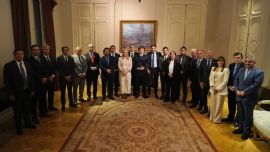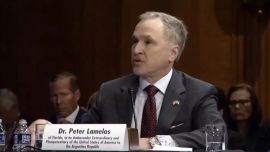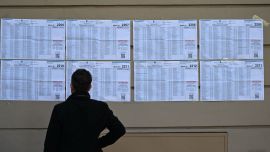Travellers are flooding Argentina by air, land and sea from its neighbouring countries to take advantage of a currency crisis making everything from ski trips to steak lunches a massive bargain compared to prices at home.
Chileans have crossed the Andes in droves to go wild at supermarkets, forcing some wholesalers in Argentina’s wine capital, Mendoza, to set hours for foreigners to make purchases. Even Uruguay’s Finance Minister Azucena Arbeleche recently acknowledged the government is losing sales tax revenue to citizens who are shopping across the border.
In April and May, the two most recent months of data, the number of Uruguayans and Chileans visiting Argentina more than doubled from a year prior, when Covid-19 travel restrictions were no longer in place.
A huge gap between Argentina’s multiple exchange rates underscores the tourism surge. While one dollar officially fetches 268 pesos due to strict government controls, visitors using foreign-issued credit cards get charged a parallel exchange rate valued at nearly 500 pesos per dollar. Other visitors tap Argentina’s black market for cash by changing US dollar bills at a similar rate to the parallel.
Argentina’s peso is the worst performing currency in emerging markets so far this year, down more than 34% despite a cobweb of government controls on the official rate.
Uruguayans drive across border on long weekends to enjoy cheap steaks and fill their car trunks with household products. It’s about 59% cheaper to buy basic goods in the Argentine border town Concordia than the Uruguayan municipality across the river, according to a survey by Uruguay’s Catholic University. Indeed, Uruguayan tourists spent more than $900 million in Argentina in the year ending March 31, according to Uruguay government data.
Wilson Bueno, a retired civil servant and sculptor, drove with his wife from their home in the city of Paysandu in northwestern Uruguay to visit relatives in Buenos Aires last month with their dollars stretching far enough to include a day-trip to a horse ranch.
“Filling the tank in Argentina costs less than half of what it does in Paysandu,” says Bueno, who also visited Mendoza on a cheap tour package this year. “We paid 3,000 Uruguayan pesos ($80) and, with a little more than 1,000 pesos, we filled our tank in Buenos Aires.”
Ski & Shop
Despite the travel boom, tourism is a net money loser for Argentina as spending by its citizens abroad exceeds the money foreign visitors bring into the country.
That’s bad news for the administration of President Alberto Fernandez, which has adopted increasingly stricter capital controls to protect the central bank’s dwindling hard currency reserves even at the cost of pushing the economy closer to recession.
Tourism agency Hiperviajes has seen the number of Uruguayans booking trips to Argentina increase 80% this year compared to before the pandemic as travelers increasingly look beyond Buenos Aires to Andean destinations like Bariloche, El Calafate and Mendoza, sales manager Rodrigo Rosales said.
“You also have people who travel abroad once or twice a year that are adding a trip to Argentina,” he said in a telephone interview. “It can cost three to four times less to eat in Argentina than in Uruguay.”
So many Uruguayans want to ski in Argentina this winter that charter airline Andes Lineas Aereas started direct flights this month from Montevideo to the Patagonian resort town of Bariloche. A one-day adult pass at Bariloche’s Catedral ski resort goes for about $58 at the parallel rate. At Chile’s Valle Nevado resort, it costs $77.
Marcela Hoffens, a dental worker from the Chilean coastal city of Viña del Mar, spent two weeks with her husband carefully planning an overnight shopping trip to Mendoza on the other side of the Andes mountains in May.
They spent big at wholesale supermarket Mayorista Oscar David where they purchased rice, cooking oil and other staples up to their duty-free quota of $300 per person. Hoffens reckons they would have paid more than double for the same goods in Chile, where one toothbrush costs the same as seven in Mendoza.
“The lines were enormous,” at the supermarket, Hoffens said. “There were a lot of Chileans.”
By Ken Parks/Bloomberg




















Comments